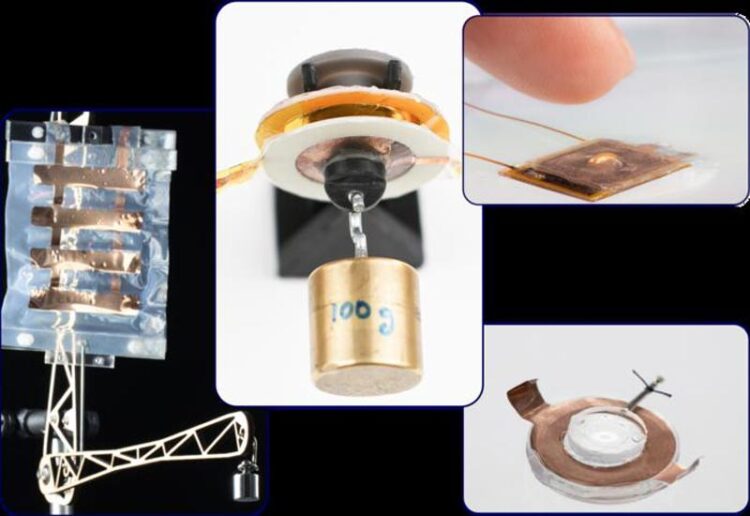Stable and efficient robotic artificial muscles built upon new material combinations

Artificial Muscles and Actuators
Credit: ©Scuola Superiore Sant'Anna Pisa
Nature Electronics publishes research from University of Linz, Scuola Superiore Sant’Anna di Pisa and University of Trento. Technological advancement meets environmental sustainability.
Actuators, which convert electrical energy into motion or force, play a pivotal role in daily life, albeit often going unnoticed. Soft material-based actuators, in particular, have gained scientific attention in recent years due to their lightweight, quiet operation, and biodegradability. A straightforward approach to creating soft actuators involves employing multi-material structures, such as “pockets” made of flexible plastic films filled with oils and coated with conductive plastics. When subjected to electrical activation, the film displaces the fluid and contracts the pocket, similar to a biological muscle. This system can be used to build artificial muscles for robots, adjustable optics, or tactile surfaces. However, until now, applying constant electrical activation only allowed short-term muscle contractions, posing a significant limitation for practical applications.
Researcher Ion-Dan Sîrbu from Scuola Superiore Sant’Anna, formerly a doctoral student at the University of Trento under the supervision of Giacomo Moretti and Marco Fontana, began investigating this phenomenon during a research period at Johannes Kepler University in Linz. Together with the Austrian research group, Ion-Dan Sîrbu developed a system that enables accurate force measurement in these actuators. “During my research on common material combinations,” Ion-Dan Sîrbu explains, “I also experimented with a plastic film that a fellow doctoral student, David Preninger, used for his work on biodegradable artificial muscles. As soon as we noticed that this material can sustain a constant force for arbitrarily long periods, we realized we had made a significant discovery.”
Since then, the team has worked on a theoretical model and conducted in-depth material characterizations. It became apparent that the key experimental results could be accurately described using simple models. “The beauty of our model is its simplicity and that it is not limited to existing actuators. We believe our results will provide the scientific community with a simple yet powerful tool for designing and investigating new systems,” says David Preninger, co-first author of the paper and PhD-student at Soft Matter Physics department at Johannes Kepler University, describing the recently published research in Nature Electronics. ” What’s interesting is that not only have we made this technology more functional, but our study enables the identification of material combinations that bring up to thousandfold energy consumption reductions” adds Prof. Kaltenbrunner.,
Utilizing the identified material combinations, scientists have successfully developed and operated various types of artificial muscles, variable gradient optics, and tactile displays. Prof Fontana emphasizes, “Understanding the fundamental mechanisms underlying soft actuators as established by this study has the potential to make a significant leap in the field of assistive devices, automatic machines, and mobile robots for terrestrial, marine, and space exploration. All these sectors are in search of low-cost, high-performance solutions, which shall also be capable of ensuring low consumption and environmental impacts for sustainability.”
Journal: Nature Electronics
DOI: 10.1038/s41928-023-01057-0
Method of Research: Experimental study
Subject of Research: Not applicable
Article Title: Electrostatic actuators with constant force at low power loss using matched dielectrics
Article Publication Date: 9-Nov-2023
Media Contact
Alessandra Saletti
Università di Trento
alessandra.saletti@unitn.it
Office: 0039-046-128-1131
All latest news from the category: Materials Sciences
Materials management deals with the research, development, manufacturing and processing of raw and industrial materials. Key aspects here are biological and medical issues, which play an increasingly important role in this field.
innovations-report offers in-depth articles related to the development and application of materials and the structure and properties of new materials.
Newest articles

Bringing bio-inspired robots to life
Nebraska researcher Eric Markvicka gets NSF CAREER Award to pursue manufacture of novel materials for soft robotics and stretchable electronics. Engineers are increasingly eager to develop robots that mimic the…

Bella moths use poison to attract mates
Scientists are closer to finding out how. Pyrrolizidine alkaloids are as bitter and toxic as they are hard to pronounce. They’re produced by several different types of plants and are…

AI tool creates ‘synthetic’ images of cells
…for enhanced microscopy analysis. Observing individual cells through microscopes can reveal a range of important cell biological phenomena that frequently play a role in human diseases, but the process of…





















